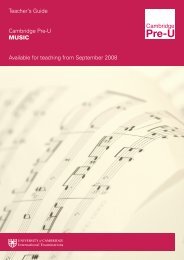Cambridge Pre-U Syllabus - Cambridge International Examinations
Cambridge Pre-U Syllabus - Cambridge International Examinations
Cambridge Pre-U Syllabus - Cambridge International Examinations
You also want an ePaper? Increase the reach of your titles
YUMPU automatically turns print PDFs into web optimized ePapers that Google loves.
<strong>Cambridge</strong> <strong>Pre</strong>-U <strong>Syllabus</strong><br />
2.4 Classification<br />
Content<br />
The species concept<br />
Classification systems<br />
Learning outcomes<br />
Candidates should be able to:<br />
a) define the term species with reference to morphological, genetic and biochemical similarities and<br />
capability to produce fertile offspring<br />
b) explain why classification systems are used to categorise organisms<br />
c) distinguish between phylogenetic (cladistic) and phenetic classification systems and understand the<br />
general preference for phylogenetic systems<br />
d) describe the hierarchy of seven major taxonomic groups from Kingdom to species with reference to an<br />
example (e.g. Homo sapiens)<br />
e) understand the term binomial nomenclature and why Latin and Greek are used for biological<br />
nomenclature<br />
f) discuss the merits of the five kingdom and the three domain classification systems (limited to utility and<br />
phylogenetic validity)<br />
g) explain the difficulties of including viruses in classifications of organisms<br />
Practical learning outcomes<br />
Candidates should be able to:<br />
i) recognise key features of the different kingdoms from specimens, photographs and drawings<br />
ii) use dichotomous keys to identify organisms from different taxa<br />
27

















